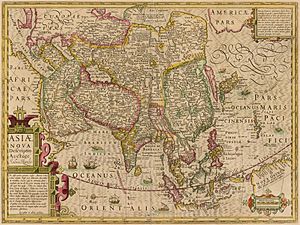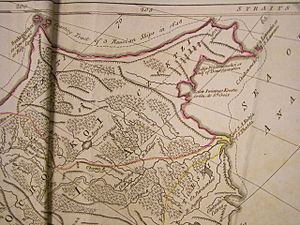Semyon Dezhnev facts for kids
Semyon Ivanovich Dezhnyov (born around 1605 – died 1673) was a brave Russian explorer of Siberia. He was the first European to sail through the Bering Strait. This happened 80 years before another famous explorer, Vitus Bering, did the same. In 1648, Dezhnyov sailed from the Kolyma River in the Arctic Ocean all the way to the Anadyr River in the Pacific Ocean. His amazing journey was forgotten for almost 100 years. Because of this, Bering often gets the credit for discovering the strait that is now named after him.
Contents
Early Life and Journeys
Semyon Dezhnyov was a Pomor Russian, meaning he came from a group of people who lived along the White Sea coast in northern Russia. He was born around 1605, possibly in the town of Veliky Ustyug. In 1630, he joined the Siberian service, perhaps as a government agent. He worked for eight years in Tobolsk and Yeniseisk.
Around 1639, he moved to Yakutia. He might have been part of a group of Cossacks (a type of soldier) led by Pyotr Beketov. Beketov is known for founding Yakutsk on the Lena River in 1632. In Yakutia, Dezhnyov married a local Yakut woman. For the next three years, he collected yasak, which was a tax paid in furs from the native people.
In 1641, Dezhnyov traveled northeast to a new river that flowed into the Indigirka River. There, he worked with another explorer named Mikhail Stadukhin. They didn't find many furs and faced unfriendly native groups. But they heard about a rich river to the east. So, Dezhnyov, Stadukhin, and Yarilo Zyrian sailed down the Indigirka. Then they went east along the coast to the Kolyma River. In 1643, they built an ostrog, which is a type of fort, there. This fort became the easternmost point of Russian control at that time. The Kolyma area soon became very rich in furs.
The Great 1648 Expedition
Around 1642, Russians started hearing about a "Pogycha River" to the east. They heard it flowed into the Arctic Ocean. The area nearby was said to have lots of sable furs, walrus ivory, and silver. An attempt to reach this river in 1646 failed.
In 1647, Fedot Alekseyev, a merchant's agent, planned a new expedition. He asked Dezhnyov to join because Dezhnyov was a government official. This expedition reached the sea but couldn't sail around the Chukchi Peninsula. They had to turn back because of thick ice.
They tried again the next year, in 1648. Fedot Alekseyev was joined by Andreev and Afstaf'iev, who also brought their own ships and men. Alekseyev had five ships and most of the crew. Gerasim Ankudinov also joined with his own ship and 30 men. Dezhnyov hired his own group of 18 or 19 men to collect furs for themselves, which was common then. The whole group had between 89 and 121 people. They traveled in traditional koch vessels, which were special boats used in the Arctic. At least one woman, Alekseyev's Yakut wife, was with them.
On June 20, 1648, they left from Srednekolymsk and sailed down the river to the Arctic Ocean. Later, they learned that two of their boats had been wrecked. The people on those boats were killed by native groups. Two other boats were lost, but we don't know how. Sometime before September 20, they sailed around a "great rocky projection." Here, Ankudinov's boat was wrecked, and the survivors moved to the two remaining vessels. In early October, a storm hit, and Fedot's boat disappeared. Years later, in 1653 or 1654, Dezhnyov rescued Fedot's Yakut wife from the Koryak people. She said that Fedot had died from scurvy (a disease caused by lack of Vitamin C). She also said that some of his friends were killed, and the rest fled in small boats.
Dezhnyov's boat was also caught in the storm. It was eventually wrecked somewhere south of the Anadyr River. The remaining 25 men walked through unknown land for 10 weeks. Finally, they reached the mouth of the Anadyr River. Twelve men walked up the Anadyr for 20 days but found nothing and turned back. Three of the strongest men made it back to Dezhnyov, but the others were never seen again. In the spring or early summer of 1649, the 12 remaining men built new boats from wood they found. They sailed up the Anadyr River. They were probably trying to get out of the open tundra and into forested areas to find sables (for furs) and firewood. About 320 miles upriver, they built a zimov'ye (winter camp) near Anadyrsk. They also made the local Anaul people pay tribute.
In 1649, Russians on the Kolyma River found a way to travel from the Anyuy River (a branch of the Kolyma) to the headwaters of the Pogycha-Anadyr. In 1650, Stadukhin and Semyon Motora followed this land route and found Dezhnyov's camp. The land route was much easier, so Dezhnyov's sea route was never used again. Dezhnyov spent the next few years exploring and collecting tribute from native groups. More Cossacks arrived from the Kolyma. Motora was killed, and Stadukhin went south to find the Penzhina River. Dezhnyov found a place where many walruses gathered at the mouth of the Anadyr. He collected over 2 tons of Walrus ivory, which was much more valuable than the few furs found at Anadyrsk.
In 1659, Dezhnyov handed over his duties to Kurbat Ivanov, who had discovered Lake Baikal. In 1662, Dezhnyov was in Yakutsk. In 1664, he reached Moscow. After selling 4.6 tons of walrus tusks, he became a very wealthy man. He was also given the title of chieftain for his discoveries. He later worked on the Olenyok River and the Vilyuy River. In 1670, he took 47,164 rubles (a soldier earned about 5 rubles a year) of tribute money to Moscow. He died there in late 1672.
What Dezhnyov's Expedition Achieved
As mentioned, Dezhnyov traveled with Fedot Alekseyev and two others, Andreev and Afstaf'iev. Dezhnyov was the only leader of this expedition who survived to tell his story. Dezhnyov sailed around the easternmost point of Asia, which is now called Cape Dezhnev. He might have even landed on the Diomede Islands. He sailed through the Bering Strait, reached the Anadyr River, sailed up it, and founded the Anadyr ostrog (fort).
Four of the seven ships were lost before they even reached the Bering Strait. Ankudinov's boat was wrecked in or near the Bering Strait. This means only two ships made it past the strait. Some people believe Alekseyev's boat landed near the Kamchatka River on the coast of Kamchatka. It seems that experts only agree on the fate of Dezhnyov's ship, which was not lost.
At the time, many people thought these ships had reached the American shore. They believed the men had started a Russian settlement there. Many Russian expeditions later searched for such a colony, especially in the early 1800s.
A Discovery and Its Re-discovery

Since at least 1575, European mapmakers had heard about a Strait of Anián. This was believed to be a waterway connecting the Pacific and Atlantic oceans. Some maps placed it where the Bering Strait is today. Others showed it running from the Gulf of California to Baffin Bay. We don't know for sure if Russians in Siberia knew about it. The first Western map to show a Strait of Anian between Asia and North America was probably made by Giacomo Gastaldi in 1562. Many mapmakers followed this idea until Vitus Bering's time. The idea is said to come from an interpretation of Marco Polo's writings.
Dezhnyov could not read or write very well. He probably didn't understand how important his journey was. He certainly didn't sail to Alaska or prove that there was no land bridge connecting Asia and North America. He also didn't compare his knowledge to that of learned geographers. He never claimed to have discovered the eastern tip of Asia. He only said he had sailed around a large rocky point on his way to the Anadyr River.
Dezhnyov sent reports to Yakutsk and Moscow, but they were ignored. This was probably because his sea route wasn't useful for travel or trade. For the next 75 years, confused versions of Dezhnyov's story were told in Siberia. Early maps of Siberia were not very accurate. But most seemed to show a connection between the Arctic and Pacific oceans. A few maps hinted at Dezhnyov's journey. Dutch travelers heard about an "Ice Cape" at the eastern end of Asia. Bering heard a story that some Russians had sailed from the Lena River to Kamchatka.
In 1728, Vitus Bering entered the Bering Strait. When he reported his journey in Europe, he got the credit for the discovery. In 1736, Gerhardt Friedrich Müller found Dezhnyov's reports in the Yakutsk archives. Parts of the story then started to reach Europe. In 1758, Müller published a book that made Dezhnyov's story widely known. In 1890, Oglobin found a few more documents in the archives. In the 1950s, some of the original documents that Müller had copied were found again in the Yakutsk archives.
Doubts About Dezhnyov's Route
Since at least 1777, some people have doubted Dezhnyov's story. There are a few reasons for this:
- The documents are not very detailed.
- No one was able to repeat Dezhnyov's sea route until Adolf Erik Nordenskiöld did it in 1878-1879. Eight attempts were made between 1649 and 1787, and they all failed. There is some evidence that 1648 was a year with unusually little ice.
- Most importantly, the documents could be read to mean that Dezhnyov only sailed around a cape on the Arctic coast. Then, his ship was wrecked on that coast, and he walked for 10 weeks south to the Anadyr.
However, most experts today agree that Dezhnyov's story, as we know it, is mostly correct.
Honoring Dezhnyov
Many places are named after Semyon Dezhnyov. These include a mountain ridge in Chukotka, a bay in the Bering Sea, a settlement on the Amur River, and Cape Dezhnyov (the easternmost cape of Eurasia). There is also a crater on Mars called Dejnev. Both the Soviet Union and Russia have named icebreakers after him.
See also
 In Spanish: Semión Dezhniov para niños
In Spanish: Semión Dezhniov para niños



